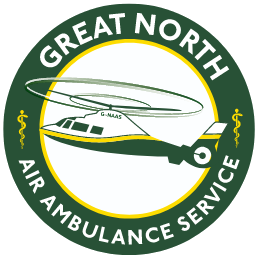Over the space of five years, GNAAS doctors Laura Duffy and Jeff Doran transformed the charity’s Pre-Hospital Emergency Medicine Crew Course (PHEMCC) into a learning destination for clinicians from the UK and beyond. This year, they handed over the reigns to colleagues Jamie Walsh, Doogie Howes and Dan Bearn. Here, Laura and Jeff share five things they learned from running the course.
1 – Making and running a course like this has so many moving parts. It takes months of planning and regular meetings. More work than we ever thought.
We got asked to take the course on when we became consultants. It was ready for a reinvigoration. We wanted to move from it being a course where people were being lectured at, to something where they were learning interactively. It’s not about pouring information into people, we ask people to do the pre-reading and then we put that into practice in a realistic environment. That’s what pre-hospital critical care is all about – dealing with the environment in which you are operating. All the participants will know their stuff, but it’s when the environment comes into play that things get challenging, and that’s what we try to recreate.
2 – We’re still so surprised with how good the course is. We are so proud that it’s one of the best PHEM courses out there and attracts people from all over the world.
After the night time scenario towards the end of week two, we get the participants to reflect on how they have changed their approach since the first exercise on the first day. This is just after they’ve performed open chest surgery out under the temporary floodlights, with all the unexpected distractions we throw into the mix. It’s only then, when they think back, that they realise how far they’ve come.
3 – We couldn’t have done it without the support of our partners, the GNAAS hierarchy and all the instructors.
A lot of the success we have had has been down to the partnerships we have created. As in our real life work, we are just one small part of a bigger machine. To have a successful outcome, whether in training or in actual patient care, you need to embrace that machine. Developing those relationships with County Durham and Darlington Fire Service, which led to us using their training centre at Bowburn, and then with Northumbria Police, which led to us using their Follingsby site, were so important. This has allowed us to deliver the high-fidelity exercises which make it all so realistic and which the candidates all love. We just couldn’t do that by ourselves.
4 – The course and manual were reviewed every year and we always strived to better last year’s performance, keep everything as up to date as possible and make improvements.
We send the manual out in advance so the participants can learn the theory. That way when the participants turn up we can start to put that learning into context through the scenarios. The theory can be relatively straight forward in the black and white of a manual, but what if that patient is still trapped under the wheels of a truck? Or what if there is an active shooter situation ongoing while you are dealing with the patient? We have always looked to push it forward and to challenge candidates.
5 – The course has brought the team closer together – it feels more like family.
We didn’t really know each other when we started on this. It was a big job as we were starting from scratch. There were a lot of late nights. We live quite far apart so we used to meet up in service stations or remote business parks. But as more and more people came through the courses, we made a conscious effort to keep them on as teachers. So instead of it just being us two doing everything, we had six, and it kept growing from there. This year, we had people coming and going throughout and there were about 15 helping out with the running of the course.
As well as the GNAAS staff who have come through the course and gone on to be vital team members, we remain in contact with many previous course candidates and we are seeing them progressing in their pre-hospital critical care careers. We have one recent candidate who is transforming his service in Costa Rica, while two from last year’s course have recently taken up roles in the services in Northern Ireland and Wales. It just validates everything we’ve been working towards. We are proud of it, and ready for a break, but we’re also excited about the course’s future in the hands of Jamie, Doogie and Dan.
Applications for the 2020 GNAAS courses are now open. Read more here.


